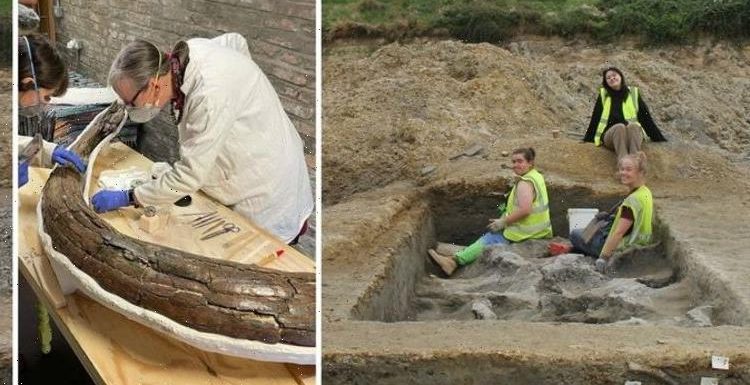
River Thames: Londoner discovers WOOLLY MAMMOTH tooth
We use your sign-up to provide content in ways you’ve consented to and to improve our understanding of you. This may include adverts from us and 3rd parties based on our understanding. You can unsubscribe at any time. More info
Sally and Neville Hollingsworth, two amateur archaeologists, made a quite incredible find five years ago when they discovered the leg bone of a mammoth dating back some 215,000 years ago. Their once-in-a-lifetime find proved just the beginning of a remarkable project spanning almost five years, unearthing the history of bones more typically found in Siberia than the suburbs of Swindon. The Cerney Wick quarry was once the home of at least five mammoths, all of which died at the site.
Site owners Hills Waste gave archaeologists more time to excavate when they realised it was an archaeological goldmine filled with the remains of five mammoths that once roamed the Cotswolds, weapons and tools used by Neanderthals, remains of ancient elks with antlers 10ft wide and a host of other things.
The discoveries were the subject of BBC documentary “Attenborough and the Mammoth Graveyard”.
Sir David and evolutionary biologist Professor Ben Garrod visited the site to investigate what had been found.
The layers of sediment beneath the surface of the quarry revealed the bed of a prehistoric river.


Sir David said: “This is probably the ancient route of the River Thames, which today lies nearly two miles away.”
He asked: “Could the mammoths have died further upstream and their bones been washed here when the river flooded?”
The team plotted target areas for excavation to find out.
Every shovel of soil was put through a sieve in their search for bone fragments.

One section saw a series of bones, including a rib and mandible, all in close proximity.
Lisa Westcott Wilkins, managing director of DigVentures, the team working on the site, explained: “One of the things that we wondered, with so many of these tusks around, could it have been that they all fall into the river somewhere and then get washed down in one big event.
“But what we’re looking at is not a high energy environment. If it was a washout, you would expect to see more debris in the channel, more debris in the sediment around the tusks.
“But the tusk is basically lying where it fell.”
DON’T MISS:
Archaeologists stunned by China’s ‘unique underwater world’ [INSIGHT]
Archaeologists baffled by skeleton that had been ‘rolled into a ditch’ [DISCOVERY]
Archaeologists solve tragic World War 2 aircraft puzzle: ‘Beyond doubt [REVEALED]

The same applied to another nearby tusk, leading Ms Westcott Wilkins to question whether the mammoth might have “just died and fell”.
The most complete bones appeared to be lying in what was once the river bed, and had been covered by the fine sediment of slow moving water, rather than being pounded by flood water.
This suggests the mammoth would have died where they were discovered.
Close to the mammoth remains were a number of stone tools made by Neanderthals — our closest ancient human relatives.

Prof Garrod told The Observer last year: “Were they hunted by people?
“Were Neanderthals crouching down in the rushes and chasing them into the water? Possibly.
“There is definitely an association between a wonderful hand-axe and other stone tools and these bones.
“Did they chance upon this bunch of dead mammoths and have a mammoth buffet? Or was it just really muddy?
“With elephants today, if a juvenile gets stuck, often the adults won’t leave the site. They’ll try and help them.”
Research remains ongoing as to how exactly the mammoths died.
Prof Garrod told ScienceFocus: “We don’t know whether [the Neanderthals] found them dead, and then butchered them, or whether they killed them and then butchered them.”
Attenborough and the Mammoth Graveyard is available on BBC iPlayer.
Source: Read Full Article